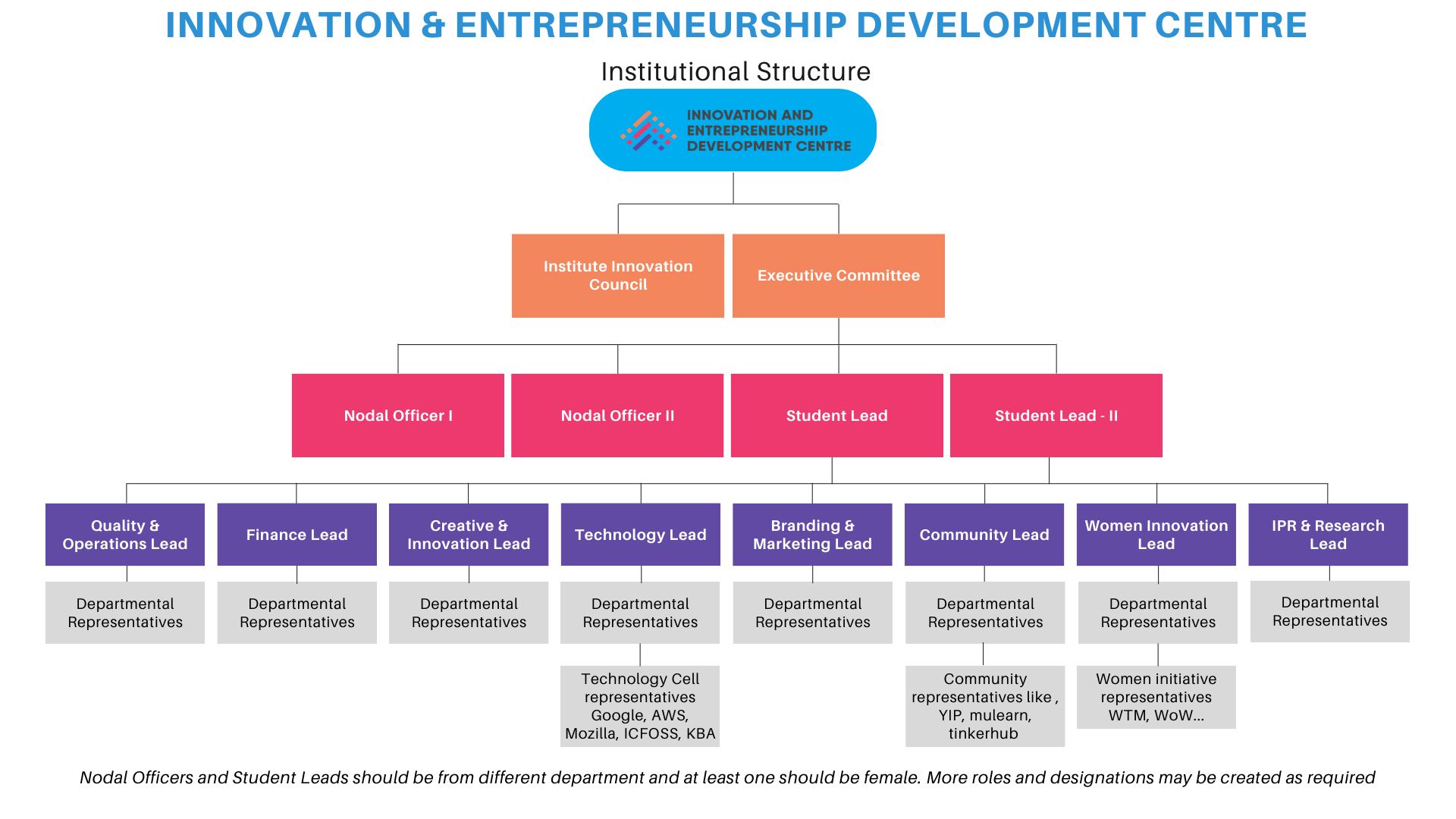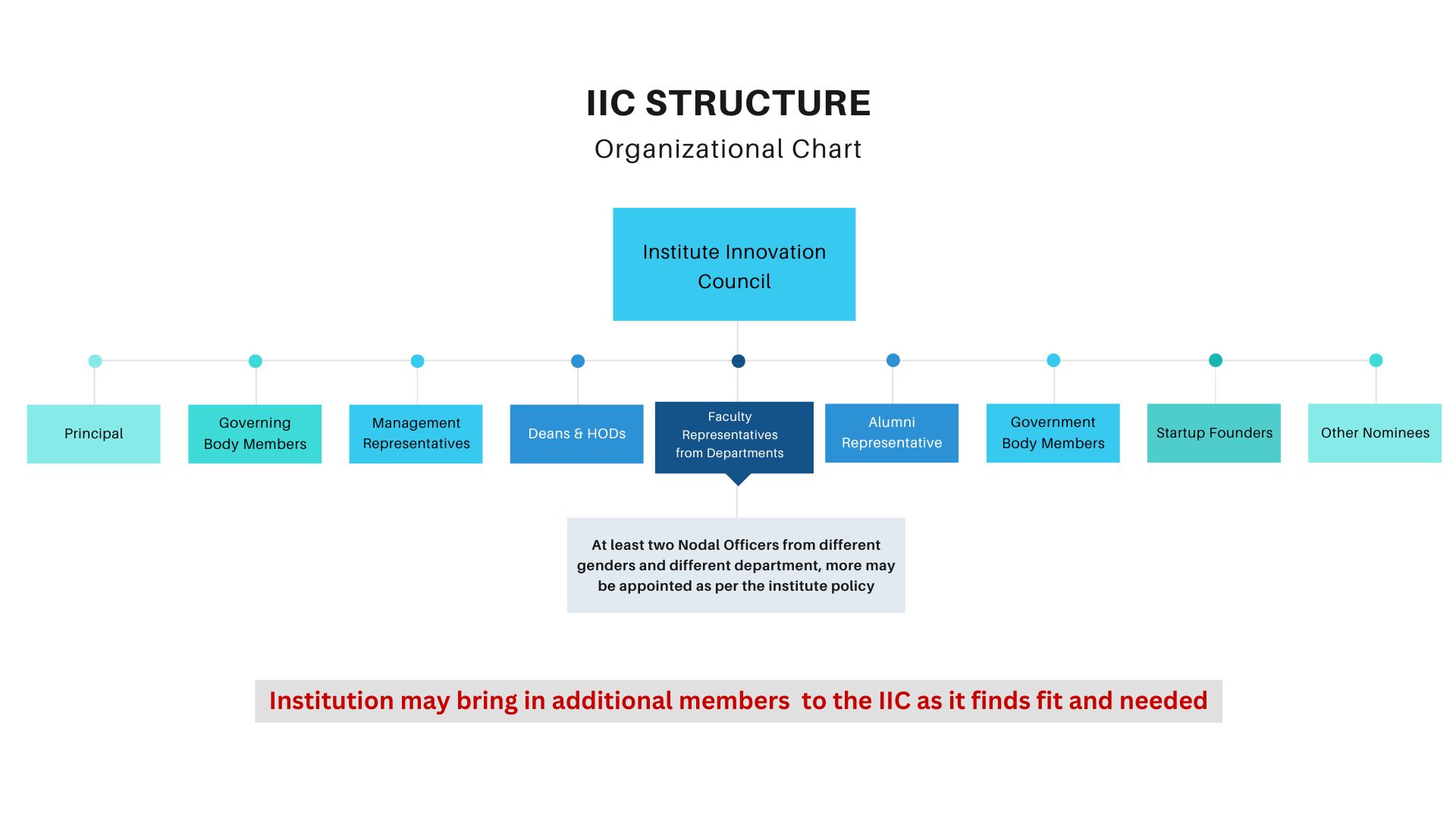An IEDC Executive Committee is formed annually, comprising institution representatives,
the nodal officers (at least two nodal officers from different departments and one should be a female one)
and student innovators from various leadership
roles within IEDC. This committee oversees the planning, execution, and evaluation of IEDC
activities.Students interested in tech-enabled entrepreneurship and innovation join IEDCs.
The institution identifies key innovators for various roles within IEDC.
- Student Lead I and Student Lead II Should be from different departments and atleast one should be a female
- Represent the student body and voice concerns to the IEDC.
- Foster a positive and inclusive environment for all members.
- Coordinate student activities and events.
- Act as a liaison between students and other leadership roles.
- Technology Lead
- Oversee the technological infrastructure of the organization.
- Identify and implement innovative technologies to enhance efficiency.
- Manage the organization's website, software, and other tech tools.
- Provide technical support to other teams and members.
- Quality & Operations Lead
- Ensure the smooth functioning of day-to-day operations.
- Implement and improve processes to enhance efficiency.
- Monitor and maintain the quality of products or services.
- Collaborate with other leads to streamline cross-functional processes.
- Finance Lead
- Manage the organization's budget and financial resources.
- Oversee financial transactions, accounting, and reporting.
- Provide financial guidance to other leads for budgeting their activities.
- Identify opportunities for cost-saving and revenue generation.
- Creative & Innovation Lead
- Drive creative initiatives and innovative projects.
- Foster a culture of creativity and out-of-the-box thinking.
- Collaborate with other leads to infuse creativity into various aspects of the organization.
- Oversee the development of creative content and materials.
- Branding & Marketing Lead
- Develop and execute marketing strategies to promote the organization.
- Manage branding efforts to enhance the organization's image.
- Coordinate promotional events and campaigns.
- Work with other leads to ensure consistent messaging across all channels.
- Community Lead
- Build and nurture a sense of community within the organization.
- Organize community-building events and activities.
- Address the needs and concerns of the organization's members.
- Foster collaboration and networking among members.
- IPR & Research Lead
- Oversee intellectual property matters and research activities.
- Ensure compliance with intellectual property laws and regulations.
- Facilitate research projects and collaborations.
- Support innovation and protect the organization's intellectual assets.
- Women Entrepreneurship Lead
- Can work independently under the guidance of Nodal Officers on women-centric and inclusive innovation projects.
- Lead initiatives that empower women in innovation, entrepreneurship, and leadership.
- Develop and implement programs to promote gender inclusivity across all innovation activities.
- Collaborate with industry, academia, and government bodies to support women-led projects.
- Mentor and support women innovators in research, product development, and IPR filing.
- Facilitate training, workshops, and networking opportunities for women entrepreneurs.
- Represent women innovation initiatives in institutional, regional, and national forums.
- Report directly to the Nodal Officers with progress updates and project outcomes of specific activities.
- i. Announcement of election: Announce the opening of student lead positions in the IEDC through various
communication channels, including posters, emails, and social media.
Clearly outline the eligibility criteria, which may include a minimum GPA, a demonstrated interest in
innovation and entrepreneurship, and active participation in related activities.
- ii. Nomination Submission:Establish a dedicated platform for the submission of nominations.
Nominees should provide a comprehensive statement of interest highlighting their motivation, relevant
experiences, and a vision for promoting innovation and entrepreneurship within the IEDC.
- iii. Initial Review: Form a screening committee to conduct an initial review of all applications for
completeness and adherence to guidelines.
Identify and address any discrepancies or missing information through direct communication with the candidates.
- iv. Short listing: Evaluate applications based on criteria such as the candidate's passion for
innovation, demonstrated leadership, and alignment with the IEDC's mission.
Shortlist candidates who exhibit strong potential for contributing to the IEDC's goals.
- v. Panel interview Organize panel interviews involving representatives from the IEDC, faculty members,
and external experts.
Structure interviews to assess candidates' understanding of innovation, their entrepreneurial mindset,
and their ability to work collaboratively.
- vi. Case study or presentation: Introduce a case study or presentation component to evaluate candidates'
analytical and communication skills.
Topics may include proposing an innovative project, addressing a real-world entrepreneurial challenge,
or presenting their vision for the IEDC.
- vii. Evaluation and scoringEstablish a scoring system to evaluate candidates based on their interview performance,
application materials, and references.
Consider factors such as innovation mindset, leadership potential, and communication skills in the evaluation process.
- viii. Selection Committee meeting:Convene a meeting with the selection committee to discuss and finalize student lead selections.
Ensure thorough deliberation and consensus-building among committee members.
- ix. Announcement: Announce the selected student leads to the IEDC community through a formal communication channel.
Acknowledge the efforts of all participants and express gratitude for their interest in contributing to the IEDC.
- x. Transition Period: Facilitate a smooth transition by organizing handover sessions between outgoing and
incoming student leads.
Encourage collaboration during the transition period to ensure a seamless transfer of responsibilities.
- xi. Onboarding: Develop an onboarding program that includes training on IEDC policies, procedures, and expectations.
Introduce new student leads to existing team members and provide resources to help them integrate into their roles effectively.
- xii. Candidate feedback Collect feedback from candidates regarding their experience with the selection process.
Use feedback to identify areas for improvement and implement changes in subsequent selection cycles.
- xiii. Process evaluation: Conduct a post-selection evaluation with the selection committee to assess the
effectiveness of the process.
Identify strengths and weaknesses to inform improvements in future selection processes.
- xiv. Regular update:Communicate regularly with the IEDC community, providing updates on the progress of the selection process.
Maintain transparency in the communication of key milestones and decision
- xv. Transparency: Ensure transparency throughout the decision-making process by clearly communicating the
criteria, steps, and rationale behind decisions.
Address any inquiries or concerns from candidates or the IEDC community with openness and clarity.

